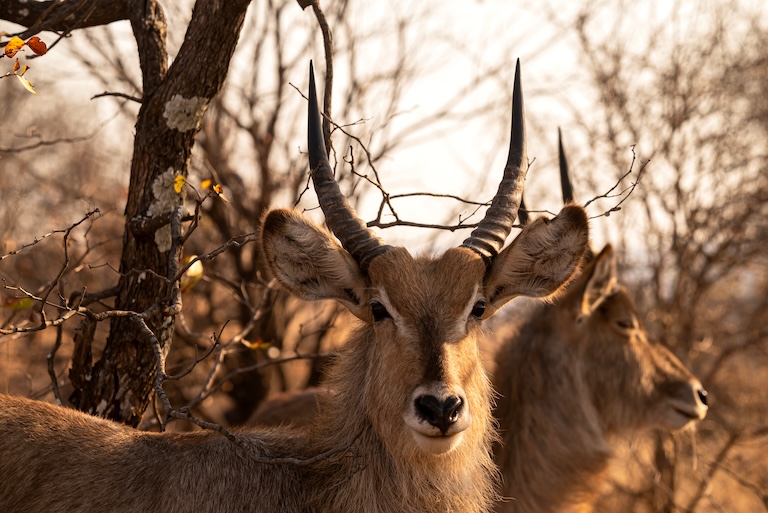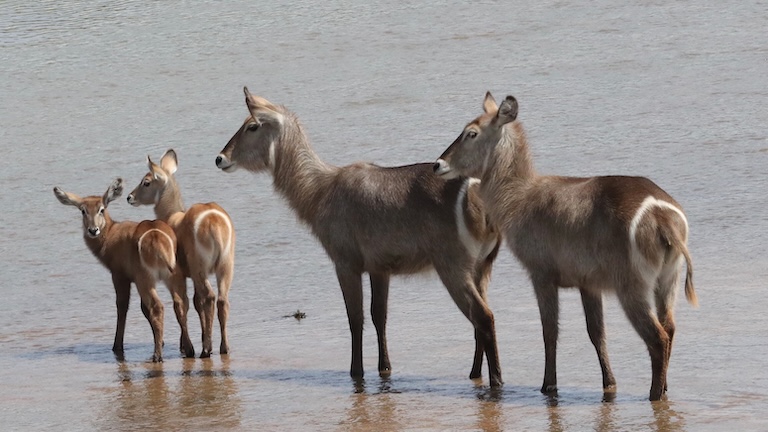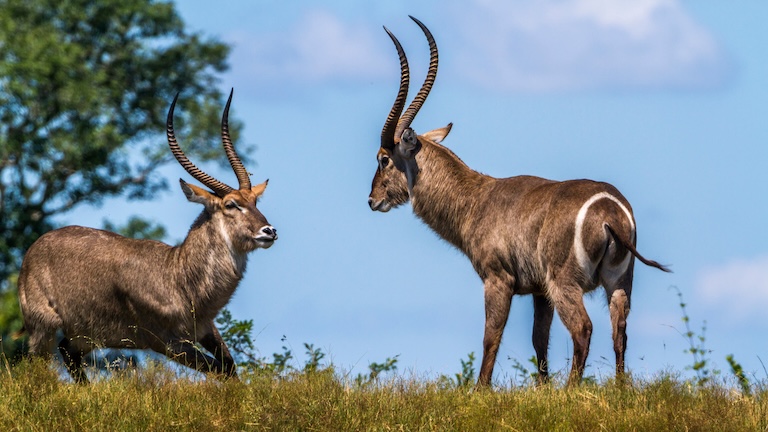Waterbuck Profile
With the almost-total eradication of wildlife in developed environments it’s easy to lose sight of just how tough life can be in the wild. Of all places on Earth, the plains of Africa might be the most hostile.
For herbivores like the waterbuck, avoiding the terrifying terrestrial predators often means sharing their forage routes with furious hippos and hungry crocodiles.
So, the fact that they are still thriving as a successful species speaks volumes to their toughness and tenacity.

Waterbuck Facts Overview
| Habitat: | Savanna, grassland, wetland |
| Location: | Southern and Eastern Africa, West and North Sub-Saharan Africa |
| Lifespan: | 18 in the wild, 30 in captivity |
| Size: | Up to 127 cm (50 in) at the shoulder |
| Weight: | 262 kg (578 lb) in large males |
| Colour: | Darky grey or brown |
| Diet: | Water plants, grasses |
| Predators: | All of them: Lion, leopard, cheetah, wild dogs, crocodiles, etc. |
| Top Speed: | Possibly up to 50 km/h (31 mph) |
| No. of Species: | 1, but 13+ subspecies split into two varieties |
| Conservation Status: | Least Concern (IUCN) |
Waterbucks are the biggest of the six Kobus species of spiral-horned antelope, and this definitely helps them survive in such a hostile environment.
Few predators are up to the challenge of bringing down an adult male but the smaller juveniles and females are under constant threat from land and water.
Thankfully, they’re very smelly, so this helps them avoid predation to some degree, and despite being more reliant on water than other Kobus species, they are one of the more widespread and successful antelope in Africa.
Interesting Waterbuck Facts
1. They’re very widespread
There are a lot of Waterbuck! They can be found from Senegal to Ethiopia, and all the way down into South Africa. A population this size is bound to have some regional diversity, and in the waterbuck, this comes in the form of 13 recognised subspecies.
These are grouped into two, with four subspecies in the common, or elipsen waterbuck, and the remaining nine subspecies in the defassa waterbuck group. They don’t look all that alike, though probably more like one another than other species, and the best way to tell them apart is to compare the rears.

2. Look at their butts
It’s not an exaggeration to say that many species of antelope are best identified from behind. Tail length, colour, number of bands, and even the specific wiggle it makes can all be used to identify antelope species.
In waterbuck, to tell the common from the defassa, you’ll be looking for a white ring or ellipsis around the rump. The species name ellipsiprymnus refers to this, and it’s not pronounced on the defassa subspecies. 1
3. They’re territorial
Waterbuck are not good at holding onto water, like many other dry land antelope. They are marshland specialists, spending most of their time in and around water, and are mostly sedentary, meaning they need to defend what they’ve got.
As such, they’re territorial and begin dominating areas of land at around five years. They hold territories of up to 146 hectares which, since they lack common scent glands on their feet, face and groin, takes a lot of scent marking with dung and urine.
Territorial displays make use of the thick shaggy neck and the bright patch on the throat to show their musculature. Fights do occur and can be lethal as a result of the piercing horns.
By around ten years old, their reign comes to an end, and youngsters take over their lands. Old males retire to a smaller area. 2
4. It’s a hard life
Aside from rival males, waterbucks have a lot to contend with. Being so comfortable in the water gives them refuge from a lot of the standard savanna hunters like lions and wild dogs, but can also put waterbuck into hippo territory.
Hippos will kill intruders out of principle and may even eat them on occasion, so it’s better to stay out of their way. Crocodiles are also a threat.
To make matters worse, waterbuck appear to not particularly like being in the water, they’re just forced into it by the circumstances. Still, they have evolved some watery adaptations to handle the aquatic environment. 3

5. Greasy kob
When a male waterbuck is aroused, it becomes oily. This secretion makes their neck fur look darker and is apparently quite off-putting to predators, as well as providing their bodies with a nice waterproof coating.
This phenomenon led to their French moniker, “Cobe oncteux” which translates to “greasy kob”, and may explain why they aren’t entirely reduced by human hunters, either.
6. They dehydrate
Its diet is up to 95% grass, and so it has relatively specific requirements that fix it in place. These animals dehydrate easily, so can’t travel far into dry areas. They’re known to venture up rivers well into forests, more than their relatives, but rarely venture far from the source of drinking water.
Despite their lack of appeal and widespread distribution, this has proven to be a handicap for the species, as being so dependent on water makes it vulnerable to habitat conversion.
7. They’re in decline
Both the common and defassa waterbuck are decreasing in number. Poaching and hunting have dented their populations in areas where there is more rapid development, and some populations have been entirely eliminated.
The contamination of waterways is a major concern, as lake populations in Kenya were found to have dangerously high levels of cadmium and lead.
Waterbuck population counts are woefully out of date. We have records from 1999 that give an estimate of 200,000 individuals, and not much more recent than this. While the species is considered in decline, it’s not yet thought to be at risk of extinction.
Still, there are a few serious concerns for their conservation. 4
Waterbuck Fact-File Summary
Scientific Classification
| Kingdom: | Animalia |
| Phylum: | Chordata |
| Class: | Mammalia |
| Order: | Artiodactyla |
| Family: | Bovidae |
| Genus: | Kobus |
| Species: | Ellipsiprymnus |
Fact Sources & References
- “Female Waterbuck Showing White Ring on Rump”, Wildlife Pictures Online.
- C Spinage (2012), “A Territorial Antelope: The Uganda Waterbuck”, Google Books.
- Savanna Private Game Reserve (2021), “Wild dogs Hunting Waterbuck”, YouTube.
- “Waterbuck”, IUCN Red List.
